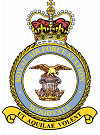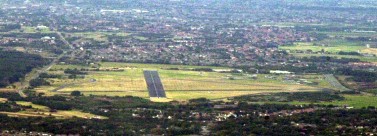 |
RAF Woodvale |
|
 |
 |
 |
|
After the war as
DURING
World
War 2, a Q site, (night bombing decoy), in what was then Lancashire, was
put into service. Near Formby at Downholland Moss the
remains of control shelter for a Q site still stand
today as well as many gunning emplacements all over the
coast and around the airport. Q sites were night bombing
decoys. This one was built to decoy RAF Woodvale further
up the coast. The Q site itself was almost one and a
half miles long and was intended to represent an
airfield at night and consisted of a dummy flare path
for landing aircraft and a v-shaped approach funnel. The
shelter was normally situated within 400 metres of the
decoy and housed 2 generators and rest area for the
crew. There were normally 2 crew; one operated the
headlight while the other kept watch. The shelter was
covered with earth to protect it from near misses. The
earth has now fallen away.other airfields were closed, Woodvale
was to play another role with the RAF and was kept open. With the increase of air traffic from Liverpool Speke
Airport (now John Lennon Airport) in 1951 Number 611
'West Lancashire' Squadron moved to Woodvale from Hooton
Park, which was situated other side of the River Mersey.
611 Squadron conducted THUM (Temperature and Humidity)
flights using the aircraft. In 1953 Manchester
University Air Squadron moved its flying operations from
Barton to Woodvale. 1957 the No 611 Squadron was
disbanded and this also was the end of the operational
service of the British legend, the Spitfire. The last
one to fly in British military markings took of from
Woodvale that same year. Things were changing at the air
base and more none MOD operations were taking place and
in 1965 on the 3rd October, RAF Woodvale held a Dragfest.
Buddy Cortines won and posted the UK's first 200mph
terminal speed. Buddy also recorded the fastest time of
the '65 Dragfest with a 7.74/201. This stood as an
unofficial UK record until 1970. In 1975 the Manchester
University Air Squadron was renamed Manchester and
Salford Universities Air Squadron in April of that year, to
accommodate the new status of Salford University. |
 |
Once again due to its increasing commercial air traffic at
the now Liverpool John
Lennon Airport, a great deal of research was carried out
to find a new home for the Merseyside Police Air Support
Group and RAF Woodvale was identified as the most
suitable location in 1998/9. This marked a new era for the air field and in
2000 the Police force moved their helicopter Eurocopter Ecureuil
2 to a
purpose built hanger at the airfield.
The latest Merseyside
Police Air Support Group Helicopter at RAF Woodvale is a
Eurocopter EC 135 helicopter. It was brought in to service in
2002 and uses the radio call sign XM11. This was
also the privies helicopters call sign as both had been
given the aircraft
registration number starting G-XMII. As a result the chopper became known ever
since as Mike One, by the force.
In 2010 Merseyside Police put the warning out that it's The Air
Support Group could be cut as part of the forces bid to cut
millions from the national crime fighting bill. This came just
after the National Police Air Service (NPAS) project team, that
same year,
recommended that Merseyside should loses its force helicopter
and closes the Police section based at RAF Woodvale. |
|
This threat of axing the
forces helicopter lead to many local residents to reacted
angrily to the proposal put forward by the NPAS to save an estimated £15.3m a year
nationally. In 2011 The confirmation was given the
the Air Support Group was going to be axed. |
|
The History
of 631 Volunteer Gliding Squadron was started out just a
few miles away, on the river Mersey in in April 1944 as
186 Elementary Gliding School at Speke, is now official
known as Liverpool John Lennon Airport. It moved to the
other side of the river to Hooton Park in 1946 before
being moved to Woodvale in December 1947. The Squadron
was again moved in 1952 to Hawarden and renamed 631
Gliding School. In June 1963 the School was again it had
to move,
this time to RAF Sealand. In 1979 it as renamed 631 VGS,
where it remained until the closure of RAF Sealand in
March 2006, when the unit returned to RAF Woodvale. The
move ended fears at the time, that RAF Woodvale cold
have been closed under a spending review. |
 |
By its 50th
anniversary in 2011 of it's opening, the bases has had
many changes from its designed role as a combat,
airfield, built to protect the shipping lanes into the
River Mersey and to protect Liverpool from enemy
bombers. Now the site is operating in a new world
and many changes are now taking place, but its original
design purpose can still be seen if you look closely at
the base and some surrounding buildings. |
|
Also in
2011 the base celebrated 40 years of a massive public show that
takes place in and around the base called the Woodvale Rally.
It stared in 1971 and has grown into one of the biggest events
of it's type in the UK. To find out more about the
event go to:-
woodvalerally.com. |
| RAF
Woodvale now has a small number of station staff of
around 100. It's facilities now include a small
gym that holds the basic equipment, personal fitness of
its staff and that of the students. It also has a
Station Mess. The station has had a few new
buildings built since 2000 that includes an
accommodation for students and some staff. A bar,
classrooms, offices and equipment rooms, not forgetting
a control tower, a basic fire station, 3 hangers,
vehicle storage and other small utility buildings etc. |
|
|

The station is now
playing a
primary role in the UK's training of undergraduate
student pilots via the Elementary Flying Training
syllabus. Ex-UAS student pilots are then able to enter
the RAF at a stage where they can be selected for fast
jet, helicopter or multi-engine aircraft.
The AEF
provides air experience for air cadet members of the Air
Training Corps and RAF sections of the College Cadet
Force. RAF
Woodvale currently has 5 active flying units based at RAF
Woodvale:- Liverpool University Air Squadron, Manchester and
Salford Universities Air Squadron, No 10 Air Experience Flight,
No 631 Volunteer Gliding Squadron and the Merseyside Police Air
Support Group. |
|
|
|